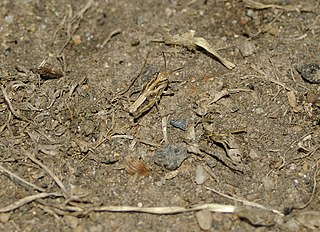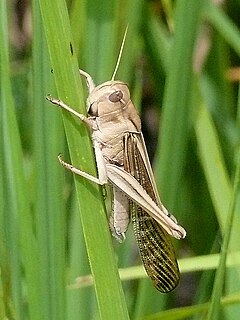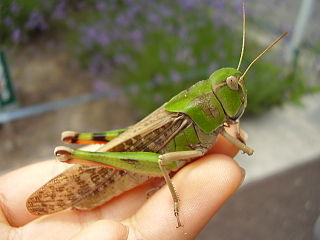 W
WLocusts are a group of certain species of short-horned grasshoppers in the family Acrididae that have a swarming phase. These insects are usually solitary, but under certain circumstances they become more abundant and change their behaviour and habits, becoming gregarious. No taxonomic distinction is made between locust and grasshopper species; the basis for the definition is whether a species forms swarms under intermittently suitable conditions.
 W
WThis is a list of locust species of the taxonomic family Acrididae capable of density-dependent phase polyphenism and swarming behavior, potentially inflicting massive damage to crops.
 W
WLocusta migratoria migratorioides, commonly known as the African migratory locust, is a subspecies of the migratory locust family Acrididae.
 W
WThe Australian plague locust is a native Australian insect in the family Acrididae, and a significant agricultural pest.
 W
WThe brown locust is a medium-sized small locust species in the monotypic genus Locustana. It is found in Southern Africa and shows classic gregarious behaviour with phase polymorphism on crowding.
 W
WThe desert locust is a species of locust, a periodically swarming, short-horned grasshopper in the family Acrididae. They are found mainly in Africa, through Arabia and West Asia, and extending into parts of South Asia. During population surge years, they may extend into parts of western Spain. The desert locust shows periodic changes in its body form and can change, in response to environmental conditions, over generations, from a solitary, shorter-winged, highly fecund, nonmigratory form to a gregarious, long-winged, and migratory phase in which they may travel long distances into new areas. In some years, they may thus form locust plagues, invading new areas, where they may consume all vegetation including crops, and at other times, they may live unnoticed in small numbers.
 W
WKosher locusts are varieties of locust deemed permissible for consumption under the laws of kashrut. While the consumption of most insects is forbidden under the laws of kashrut, the rabbis of the Talmud identified eight kosher species of locust. However, the identity of those species is in dispute.
 W
WLocusta migratoria cinerascens is a subspecies of the migratory locust in the family Acrididae.
 W
WLocusta migratoria manilensis, commonly known as the Oriental migratory locust, is a subspecies of the migratory locust in the family Acrididae. It is sufficiently different in size and structure from the African migratory locust to be considered a distinct subspecies of the migratory locust. It is found in southeastern Asia and is an important agricultural pest in the region. It is normally a solitary insect but when conditions are suitable, it enters into a gregarious phase when the young form into bands which move together and the adults into swarms. Although outbreaks may have recently been fewer in number and size because of changes in agricultural practices and better locust detection, the insects remain active as crop pests and the potential for outbreaks is still present.
 W
WMatthew 3:4 is the fourth verse of the third chapter of the Gospel of Matthew in the New Testament. The verse occurs in the section introducing John the Baptist with this verse describing his clothing and diet.
 W
WPatanga succincta, the Bombay locust, is a species of locust found in India and southeast Asia. It is usually a solitary insect, and it is only in India that it has exhibited swarming behaviour. The last plague of this locust was in that country between 1901 and 1908 and there have not been any swarms since 1927. It is thought that the behaviour of the insects has altered because of changing practices in agricultural land use.
 W
WThe red locust is a large grasshopper species found in sub-Saharan Africa. Its name refers to the colour of its hind wings. It is sometimes called the criquet nomade in French, due to its nomadic movements in the dry season. When it forms swarms, it is described as a locust.
 W
WThe Rocky Mountain locust is an extinct species of grasshopper that ranged through the western half of the United States and some western portions of Canada with large numbers seen until the end of the 19th century. Sightings often placed their swarms in numbers far larger than any other locust species, with one famous sighting in 1875 estimated at 198,000 square miles (510,000 km2) in size, weighing 27.5 million tons and consisting of some 12.5 trillion insects, the greatest concentration of animals ever speculatively guessed, according to Guinness World Records.
 W
WThe large painted locust is endemic to the Galapagos Islands of Ecuador, except Española Island. The locusts form a large part of the diet of the Galápagos hawk and lava lizards. Can be up to 8 cm long.
 W
WThe Senegalese grasshopper is a medium-sized grasshopper species found in the Sahel region of Africa, the Canary Islands, Cape Verde Islands, and West Asia. Although not called a locust in English, this species shows gregarious behaviour and some morphological change on crowding. In many parts of the Sahel, this species may cause greater year-on-year crop damage than better-known locusts, attacking crops such as the pearl millet.
 W
WValanga nigricornis, the Javanese grasshopper, is a species of grasshopper in the subfamily Cyrtacanthacridinae of the family Acrididae. It is found in southeastern Asia, the type location being Singapore. It was first described by the German zoologist Hermann Burmeister in 1838. There are more than twenty subspecies, most of which are endemic to different island groups; the subspecies V. nigricornis nigricornis is the type for the genus Valanga.